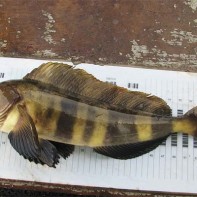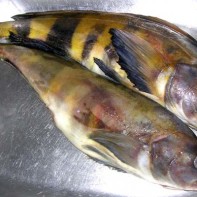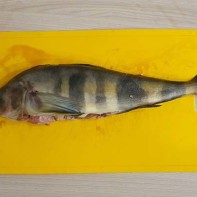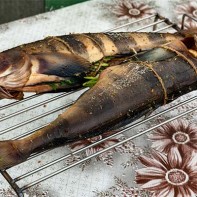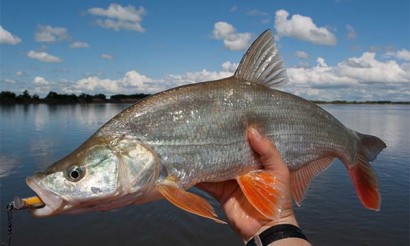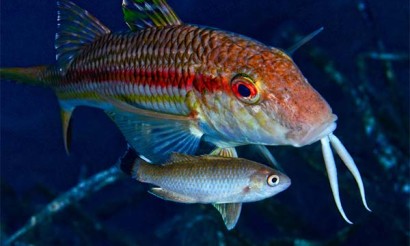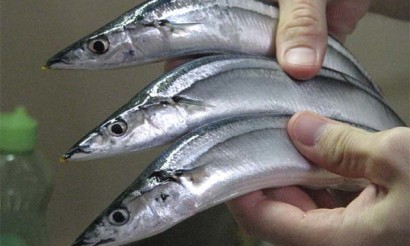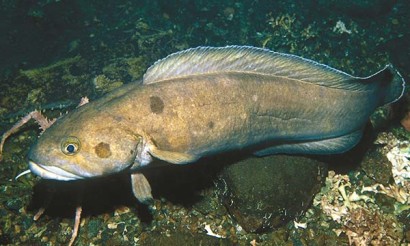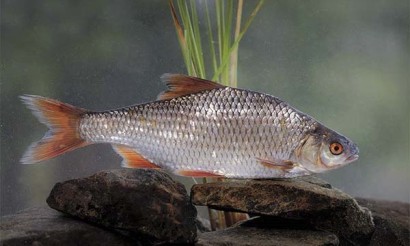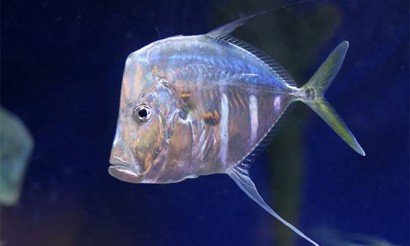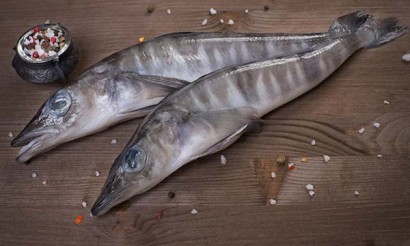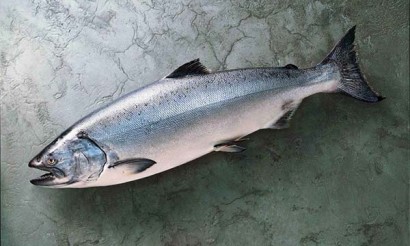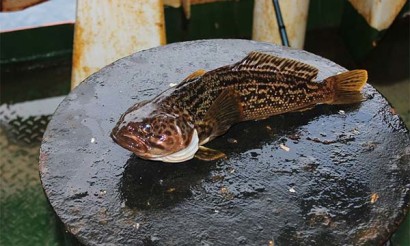Turtlefish: description, useful properties and recipes
Juicy white or yellowish meat of the Pacific endemic is low-calorie, but contains many valuable nutrients. Turpug, which is widely used in cooking, supports the central nervous system, stimulates brain function, helps to get rid of excess weight.
- Terpug: what kind of fish it is, how it looks and where it lives
- How does it look?
- Where does it live?
- What it eats
- Reproduction and life span
- Varieties
- How to catch mullet: when, where and on what?
- When to catch
- Where to catch
- What to catch
- Composition and calories
- What is useful in the meat
- Can I give children
- Harm and contraindications
- How to choose and store
- Where to buy and how much costs
- How to clean the fish
- How to cook grilled fish: Recipes
- In the oven
- In the frying pan
- In a multicooker
- On the grill
- How to smoke turpus
- Recipe for boiled fish soup
- How to cook fish cutlets
- Can be salted
- Recipe
- Q&A
- What does a burbot taste like?
- Fat or not?
- Are there many bones in the fish?
- Is the roe edible?
Blubber: what kind of fish is it, what does it look like, and where does it live?
Adult fish of the Scorpine family live bottom-dwelling lives at depths of up to 200-250 m, juveniles live closer to the surface.
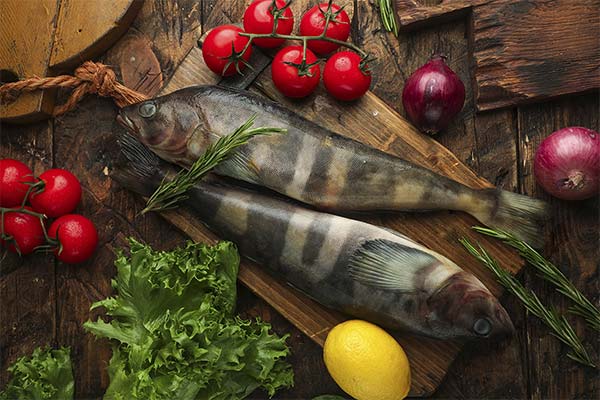
Their average weight is 0.5-2 kg with a body length of 30-50 cm. The maximum body weight of 60 kg was recorded for a caught one and a half meters long.
What does it look like?
Predatory terpugas have an elongated, runny body with fine cycloid scales and five lateral lines. Depending on the species, the gray dorsal fin with a black border extends from the head to the tail stem in a continuous band or is divided by a deep notch.
The lower parts of the head and body are yellow-brown, and the back is dark. In most species, transverse black stripes are present on the body. Convex eyes and large lips are prominent on the head.
Externally, turpug resembles an overgrown perch.
Where does it live
Sea lenok is widespread in the southeast of Kamchatka, in the northern part of the Kuril Islands, and less common in the Bering Sea.
Shoals of ground fish inhabit the continental shelf zone and coastal waters. They move to shallow waters with underwater vegetation and rocky bottoms only during spawning migrations.
What does it eat
Predators have a diet dominated by food of animal origin:
- zooplankton;
- marine worms;
- amphipods;
- insect larvae;
- juvenile fish;
- eggs;
- shrimps;
- crabs;
- winged mollusks.
Terpug is quite active. Some species make numerous vertical migrations, others do not even rise from the bottom in search of food.
Reproduction and life span
Terpugas go to spawn in September. Fish gather in large schools and swim in shallow water with a depth of 10-20 m. Females prefer to spawn in rock crevices or on rocky substrate with aquatic vegetation and strong currents.
The eggs released in portions are small (2.5 mm in diameter) and sticky. It immediately sticks to rocks and plants. In November, after hatching 20-90 thousand eggs, the females return to the depths. Males spend at least 21 days guarding their young from predators.
The larvae hatch in a couple of weeks. At first the fry stay in the water column, after six months they sink to the bottom.
The sea len lives on average 12-15 years.
Varieties
Ichthyologists are known to 9 species of turpug:
American .
The maximum weight of the representatives of the species 2 kg with a body length of 0.6 m. Occurs in the northeastern Pacific basin from Alaska to California. The fish has a strongly pronounced sexual deformity in coloration. Males with blue, blue irregularly shaped spots look more ornate than females whose monotone bodies are diluted with small dots.
Unilinear
A distinctive feature of the species is one lateral line instead of five. The length of the fish does not exceed 30 cm. The body is colored yellow-brown with dark brown spots. Single-line terpug is common in the territorial waters of Japan, Korea, in the northern part of China. Sometimes comes into the Peter the Great Bay.
Japanese
Spots of distribution of Japanese blue whales and monotonous are the same. The body length of a representative of the species is 30-50 cm. The meat is considered very tasty. Young specimens are sometimes kept in aquariums.
Brown
Habitat - Sea of Okhotsk, Japan, Bering Sea. Body length - 35-42 cm. The meat is green, but quite edible. When cooked, the pigment breaks up. The body is brown with brown spots. Dark stripes depart from the eyes; blue-white spots are scattered on the cheeks.
Hare-headed (red).
This large species grows to 0.6 m; it is common in Japan near Hokkaido island, in America from Alaska to California and in Russia on Kamchatka and in the Kuril Islands.
The Asian form differs from the American form in having short supraorbital lobes. The coloration of young red terpug is greenish-brown. Sexually mature individuals have red sides with blue spots, orange snout, gray-blue belly, and black fins.
Spotted
Spotted turpus live in all of the Far Eastern seas, occur on Kamchatka, the Kuril Islands, off the coast of Sakhalin and Primorye. The fish grows up to 45 cm and weighs 0.9, maximum 1.5 kg. The dorsal fin has a black spot at the beginning and a notch separating the barbed part from the soft part. Behind the eyes are fringed lobes. The body color is yellowish or brown with light-colored spots.
Northern monotremes
The area of the species is the Kurils, Kamchatka, Sea of Japan, Commander, Aleutian Islands, Alaska. Representatives of the species grow to half a meter tall and weigh up to two kilograms. The color of the back is dark olive, abdomen and lower part of the head is yellow. On the sides alternate transverse dark and light stripes.
Southern spotted greenshank.
The species belongs to the valuable commercial objects. Its maximum body length is 0.6 m, body weight is 1.6 kg. Southern monoterps occur in the Sea of Japan, north of the Yellow Sea, and south of the Sea of Okhotsk. Distinctive features are its long tail stem, and its coloration, which changes with age. The gray-blue color changes to gray, then to a monochromatic dark brown.
Toothy
The snakebill is the largest species of cyprinids, growing up to one and a half meters. It lives in the waters of British Columbia. It lives a solitary bottom-dwelling life at depths of up to 400 m. Characteristic features - one lateral line, no swim bladder, large mouth where numerous large and small teeth alternate.
How to fish: when, where and with what?
Lamprey is caught by fishermen with bottom trawls, seines. Amateur fishermen catch it by spinning, float tackle for angling. The Chinese raise the fish artificially in fenced off coastal areas.

When to catch
Terpug is caught almost all year round except during the spawning period. In summer the fish feed closer to shore, in November they go to the shelf zone with a depth of 200 m.
Where to catch
Walleye salmon are caught near the Kuril Islands, Aleutian Islands, Commander Islands, on Kamchatka, in Primorsky Krai. In these regions, the one-perch, red, and Japanese turpentine is widespread. It is caught from the shore and from a boat.
For successful fishing it is important to choose the right place. Biting occurs more often at transitions, where the relief of the bottom changes sharply and there are powerful underwater currents.
What to catch
Despite the small size of the fish, it is a strong and fast predator, which requires reliable tackle.
Will need a rod for vertical fishing, spinning length of 2.3 m and a rod with skipping rings up to 3.6 m.
Blanks are equipped with gearless or multiplier reel size 3500, which holds at least 100 m of fishing line with a diameter of 0.15 mm. For catching large burbot choose braided cord with a section of 0,25-0,30 mm. To hold the bait you need 60-grams sinker.
Blubber reacts well to the meat of mussels, squid, pieces of fish (smelt, herring), sea worms. Of the artificial lures choose red, silver vertical baits, heavy pilkers, jig heads with mounted vibrating tails, twisters, slags, worms.
Composition and calories
Turpug meat is rich in protein, cobalamin, pantothenic acid, riboflavin, iodine, phosphorus, potassium. The fish contains alpha-linolenic acid, which is used to treat diabetes, cardiovascular disease, obesity and joint diseases.
The content in 100 g of the edible part of the turpus of vitamins, minerals:
Vitamins:
- Cobalamin - 0,004 mg;
- Pantothenic acid - 0,75 mg;
- Riboflavin - 0,18 mg;
- Pyridoxine - 0.2 mg;
- Thiamine - 0.12 mg;
- A - 0.06 mg;
- Nicotinic acid - 1.1 mg;
- Folates - 0.009 mg;
- Ascorbic acid, 1 mg.
Micronutrients:
- Cobalt - 0.02 mg;
- Selenium - 0,04 mg;
- Chromium - 0,03 mg;
- Iodine - 0.05 mg;
- Copper - 0.15 mg;
- Fluorine - 0.43 mg;
- Zinc - 0.7 mg;
- Molybdenum - 0.004 mg;
- Manganese - 0.1 mg;
- Iron, 0.8 mg.
Macronutrients:
- Phosphorus - 220 mg;
- Sulfur - 180 mg;
- Potassium - 335 mg;
- Magnesium - 35 mg;
- Sodium - 100 mg;
- Chlorine - 165 mg;
- Calcium - 30 mg.
BZU 100 g of the product - 18, 3, 0 g, respectively. The caloric value is 102 kcal.
How is the meat of the turpug useful?
Scientists have proven that people who include sea fish in the diet on a regular basis, reduced the risk of cancer, including neoplasms of the skin, leukemia.
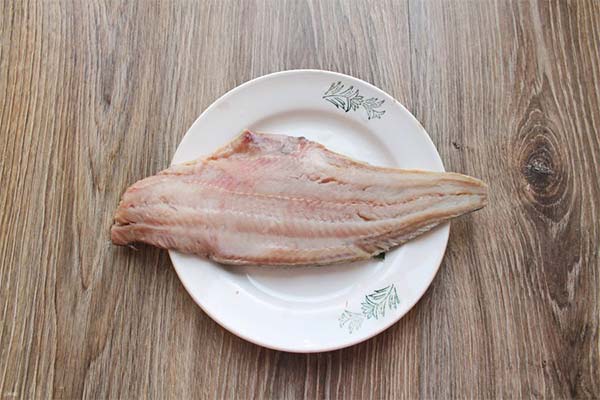
In addition, the meat of turpug at regular use:
- Increases immune status, the body's resistance to colds.
- Supplies quality protein.
- Improves the absorption of amino acids, sugars.
- Participates in hematopoiesis, hormone synthesis.
- Increases hemoglobin, prevents anemia.
- Supports the health of mucous membranes, skin, electrolyte, acid and water balance.
- Regulates energy metabolism.
- Strengthens blood vessels, prevents the formation of cholesterol plaques, the development of atherosclerosis.
- Regulates blood pressure.
- Improves blood flow, strengthens myocardium, prevents cardiac rhythm failures.
- Normalizes conduction of nerve impulses.
- Makes bones and tooth enamel denser.
- Provides synthesis of thyroxine, triiodothyronine, necessary for normal operation of the thyroid gland.
- Stimulates brain function, improves cognitive abilities.
- Prevents thrombosis, slow metabolism, anorexia, arterial hypotension, myocardiopathy, osteoarthritis.
- Detoxifies toxic substances, salts of heavy metals.
- Increases the effect of insulin.
- Supports visual acuity, nervous system function.
- Increases stress tolerance, efficiency, physical endurance.
One hundred grams of fish covers the daily requirement of the body in selenium by 66%. This trace element accelerates the regeneration of muscle and skin cells, binds and removes free radicals, prolongs youth, and prevents Alzheimer's and Parkinson's diseases.
Can we give children
Dietary meat of turpug can be given in small doses (1 tsp.) to children from nine months of age. The fish saturates children's bodies with proteins necessary for growth and development. Participates in the formation of the skeleton, prevents rickets.
Children who eat fish 2 times a week, develop faster, learn schoolwork easier, and endure physical and mental stress. They improve their metabolism, increases resistance to infection by strengthening the immune system.
Harms and contraindications
Walleye, like any other fish, is contraindicated if you are hypersensitive, allergic to fish protein.
Smoked fish is dangerous because of carcinogens formed on the surface, affecting the mucosa of the gastrointestinal tract. Fried, smoked product provokes complications of pancreatitis, cholecystitis, gastritis, liver disease, pyelonephritis.
With caution, after consultation with an endocrinologist, it is possible to consume turpus containing a large amount of iodine, people with thyroid dysfunction. If you ignore the doctor's recommendations, you can critically lose weight, blood pressure, myocardial and digestive system malfunctions will occur.
As a result of studies, scientists have proved that turpentine is able to accumulate heavy metal salts.
How to choose and store
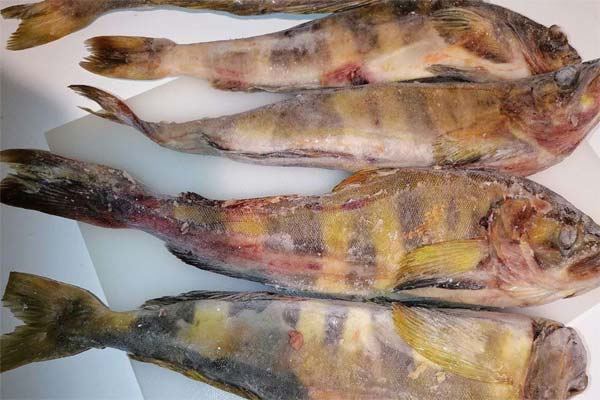
Quality turpus has a skin without mechanical damage and thick ice, indicating repeated freezing. Fresh fish is determined by clean, dark gills, tight to the head, transparent convex eyes, weak fishy smell.
Fish that has passed quality control is sold in stores. Do not buy at markets or from sellers who cannot produce a product certificate. Refrain from buying large specimens. In such fish accumulates more toxic substances, mercury, cadmium.
Fresh sea flounder is stored in the refrigerator for up to three days. In the freezer sea lent does not lose its consumer properties for one month.
Where to buy and how much costs
Walleye are sold in fish and grocery stores, on Internet sites in frozen form as a whole carcass, without the head, in the form of steaks and fillets. The average price for 1 kg is 250-350 p. Fillets cost 400-450 p.
How to clean the fish
A guide on how to cut a turpentine:
- Defrost the fish, but not all the way through. Cut off the fins with kitchen scissors.
- Place the carcass in a plastic bag with the head facing forward. Holding it by its tail, peel off the scales with a knife in motions from the tail to the head, first from the sides, then from the belly.
- Cut off the head, remove the gills, cut off the tail. Put the fish parts in the freezer. They can be used to make a delicious soup.
- Boil up the belly. Gently remove the viscera without damaging the gallbladder. Wash and dry the salmon.
If you need to separate the fillets, make a cut along the backbone, cut the meat from the bones on both sides in two layers.
How to cook tasty turpug fish: recipes
In home cooking, turpug is baked, stewed, steamed, smoked, salted, fried. From the sea lenka can be cooked boiled ukha, make cutlets. Gourmets will appreciate smoked fish and stuffed with vegetables with rice and lemon.

In the oven
To prepare a flavorful juicy dish, prepare the ingredients:
- 1.5 kg of fish;
- 4 cloves garlic;
- half lemon, orange;
- 1 tbsp. sunflower oil;
- salt, spices;
- dill greens.
Cooking algorithm:
- Clean and gut the salmon. Remove the gills from the head, wash and dry. Make several oblique cuts on each side.
- Combine minced herbs, garlic, salt and pepper in a bowl.
- Finely dice lemon. Add to the marinade, rub the contents of the bowl with your hands.
- Rub the spice mixture on the outside and inside of the carcass, leave to marinate for an hour at room temperature or three hours in the refrigerator.
- Turn the oven on, setting the temperature to 200 degrees.
- Spread foil on a baking tray and brush with oil. Spread the fish out. On top distribute half of the orange slices. Send the rest of the marinade to the stomach.
- Wrap the carcass in foil, pinch the edges.
- Bake for 45 minutes. 10 minutes before end of cooking, unroll the foil, so that a ruddy crust is formed on the terpug.
Before serving, garnish with fresh herbs, put pickled onions on a plate.
In the pan
In order not to overpower the delicate sweet flavor of fish, use spices to a minimum. Salt and black pepper will suffice. You will also need flour for breading, half a cup of vegetable oil.
How to fry:
- Clean, strip the carcass, cut into portioned pieces.
- Spices can be added to the flour or rub them on the fish.
- Heat a frying pan with oil. Roll fish pieces in breading and fry on both sides until tender.
- Remove excess oil by spreading the turpug on paper towels.
Serve fried fish with rice, pulses, fried or boiled potatoes or mashed potatoes. Combine with vegetables stewed or steamed, salted grouse, salads with cabbage.
In a multicooker
The advantage of the multicooker is that it is difficult to overdry the fish. The dish turns out tender and juicy.
Ingredients:
- one turpentine carcass;
- one head onion;
- 3 tbsp. sour cream;
- 20 ml vegetable oil;
- 5 g dried herbs;
- salt, pepper.
Cooking steps:
- Cut the fish into fillets. Cut into portions.
- Dice onion. Then put it in a greased bowl.
- Rub fish pieces with seasoning and place on top of onions.
- Mix sour cream with greens, add to fish and stir.
- Cook in baking mode for half an hour.
Serve fish cooked in the multicooker with a salad of fresh vegetables, canned corn, green peas.
On a charcoal grill
To barbecue 0.5 kg of turpus will need marinade products:
Preparation:
- Clean, gut, remove gills, rinse and dry fish. To make the rounds quicker, make incisions in the sides and remove the head.
- Dice the onion, chop and mash the tomatoes, pass the garlic through the press. Combine all ingredients, add chopped greens.
- Rub marinade all over the carcass and leave in a cool place for at least 6 hours.
- Place the fish on a rack. Cook for half an hour on coals, turning occasionally to form an even crust.
You can cook fish in foil with vegetables. The finished dish is decorated with rings of raw onion, fresh herbs, slices of lemon.
How to smoke sea lures
For evenly smoked fish, buy several pieces of freshly frozen turpus of the same size. At home, thaw the fish slowly in the refrigerator to preserve structure. Gut the fish, remove the gills and leave the scales. Rinse the fish under running water and pat dry.

Prepare mixture of salt, pepper and herbs. Rub the mixture thoroughly inside and outside, put in a glass or enamel bowl, cover with a lid, put in the fridge.
After 4 hours, wash the fish, hang it on a rope (hooks), in the kitchen over the sink or on the balcony. For the fastest drying, you can turn on a fan.
Prepare the smokehouse. Load the bottom with apple chips. Experts say that the use of other types of wood makes the meat bitter. Place the fish on the grate, close the lid, and pour water into the water trap.
Place the smoker on the stove. The optimal smoking temperature is 80 degrees. As soon as the smoke appears, time it. Forty minutes is enough. To remove excess moisture and control the process, every 15 minutes open the lid, let off steam.
Check readiness by the dorsal fin. If it separates easily from the body, the fish is ready.
Recipe for boiled fish soup
To cook 0.8 kilograms of turpentine soup, you will need:
- 2 liters of water;
- 4 tubers potatoes;
- 2 onions;
- 2 pcs. bay leaf;
- Two pinches of black pepper, salt to taste;
- 30 grams of parsley greens, dill.
Method of preparation:
- Clean the fish, remove the insides, gills. Cut off the head, trim the tail and fins. Cut the carcass into portions.
- Put a saucepan with water on the stove, put the head, trimmings and the onion, washed but not peeled. It will give the broth a golden color.
- Bring to a boil, remove the foam. Boil for 20 minutes.
- Prepare the vegetables. Peel and dice the potatoes, the second onion.
- Remove head, tail, fins and onion from the pot. Strain the broth, bring to a boil.
- Add fish pieces, vegetables, salt and pepper, and continue cooking over low heat, without covering.
- Then add salt, bay leaf, and pepper 10 minutes before cooking time.
Before serving, sprinkle chopped greens.
How to cook fish cutlets
For the minced fish cutlets of two large turpus, prepare:
- two onions;
- 70 grams of pulp of young zucchini;
- spices, salt.
To fry the cutlets in the oven, you will need a little vegetable oil, 100 g of breadcrumbs.
Cooking steps
- Cut the fish into fillets. Cut it into small pieces.
- Peel and chop onion and zucchini.
- Pass fish pieces and vegetables through a mincer.
- Salt and pepper the mass, knead it.
- Turn on the oven to 180 degrees for preheating.
- Grease a baking pan with oil.
- Form the minced meat into cutlets. Roll them in breadcrumbs, put them in a mold, and send to the oven.
- Cook a tasty dish for 20 minutes.
Fish cutlets are eaten with pasta, universal potatoes, seasoned with butter.
Can I Salt
It is possible to salt the turpug, but some housewives are limited to heat treatment, doubting the freshness of the fish because of the unpleasant color of the flesh. Another reason for the rare use of this method of processing is the short shelf life of the salted product. It should be eaten in three days at most.

Recipe
To cook fish deliciously, in addition to turpug, you will need salt, ground black and oregano pepper, a couple of bay leaves, coriander.
How to salt:
- Slowly thaw the fish in the refrigerator.
- Cut off the head, sweat out the belly, and remove the insides. Rinse off the blood, pat dry with paper towels. Separate fillet halves from spine and rib bones.
- Slice the flesh into thin slices while removing the skin.
- Make a mixture of salt and spices. Pour the seasonings into a food container. Lay fillet slices on top in a single layer, sprinkle with spice mixture, put bay leaves.
- Repeat until fish is done.
- Close the container with the lid, put it in the fridge overnight.
You can pickle the whole carcass. To do this, rub the fish on all sides with salt, spices, wrap it in a cotton cloth and take it out into the cold. Salting brisket weight up to one and a half kilograms salts at least 12 hours, if the weight is larger, it takes at least a day.
Q&A
Lovers of fish days and hostesses who want to feed the family with delicious and healthy food, are interested in the gastronomic characteristics of sea lenk.
What does sea ling taste like?
In terms of taste, sea ling is compared to halibut, salmon. It has tender meat with a pleasant fishy taste, a sweetish flavor.
Fatty or not?
Terpug belongs to the dietary low-fat fish species. There is only 3% fat per 100 g of the edible part. Low-calorie product can be included in the menu for weight loss and for the prevention of gaining excess weight.
Are there many bones in fish?
In the meat of sea turpentine there are almost no bones. Even the thin ribs become soft after heat treatment.
Is the caviar edible?
Sea bream caviar is not only edible, but also tasty and useful. The salted product is not hard to find in chain supermarkets. In home cooking caviar is salted, fried and smoked together with fish.
The right choice of tender meat is suitable for all kinds of cooking. But the most preserved nutrients are in fish, cooked on steam and in the air grill. If the priority is not the benefits, but the taste, it is worth flax stuffed or smoked.
«Important: All information on this site is provided for informational purposes only. purposes only. Before applying any recommendations, consult a health care professional. specialist. Neither the editors nor the authors shall be liable for any possible harm caused by materials."

